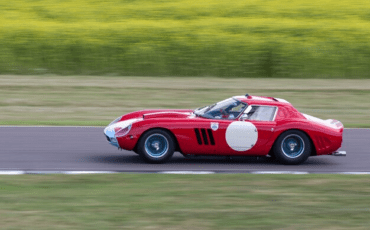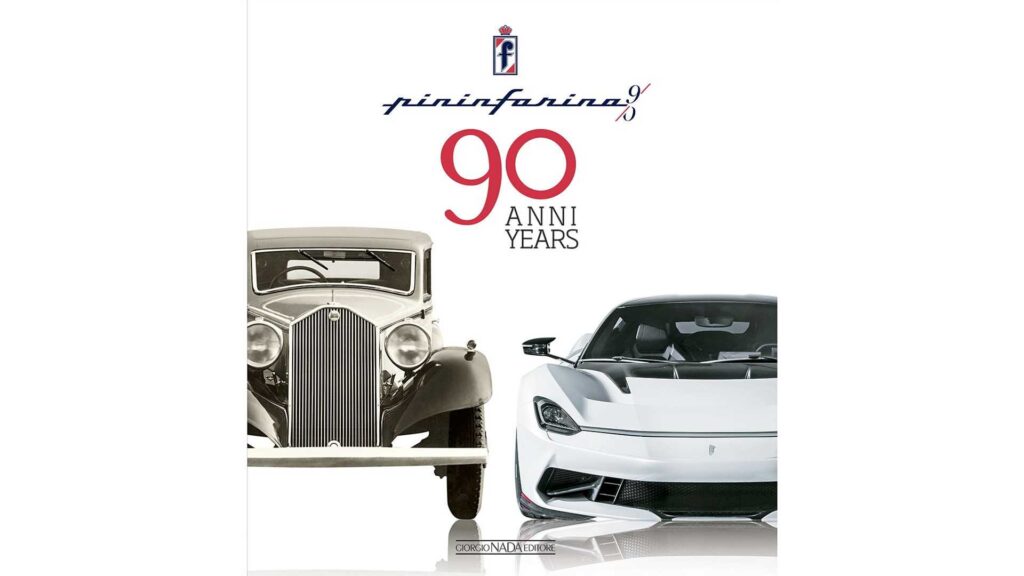
The volume describes over 600 models that, from 1930 to today, have dictated the history of the motor car and spread Italian style around the world
Five hundred and twenty-eight pages, more than 800 colour and black and white photographs accompanied by short descriptive texts documenting, model by model, Pininfarina’s production during these “first” ninety years of its history. This, in extreme synthesis, describes “Pininfarina 90 anni/90 years”, the official book that is being published on the occasion of the ninetieth anniversary of the historic Turin design studio under the imprint of Giorgio Nada Editore, in close collaboration with Pininfarina.
Ninety years is a highly significant milestone and marks a journey on which Pininfarina – founded in Turin in 1930 by Battista “Pinin” Farina – has shown itself able on more than one occasion to innovate Italian car design and more. In the light of evolving taste and stylistic horizons, it has managed at the same time to introduce solutions that target the future. In almost a century, this intriguingly unique path has seen the historic Italian brand sign one-off models, models that end up on the assembly line for high volume production, but also futuristic concept cars that in many cases have become authentic icons of Italian design in the world.
This striving to innovate was the hallmark of Pinin Farina – at the time still written in two separate words – from its very beginnings. In the Thirties, for example, the coachbuilder was acclaimed for its de luxe creations of particular sobriety and elegance, tackling the first problems related to aerodynamics with models like the “Tipo Bocca” aerodynamic cabriolet of 1936, the same year as the Alfa Romeo 6C 2300 Pescara berlinetta aerodinamica.
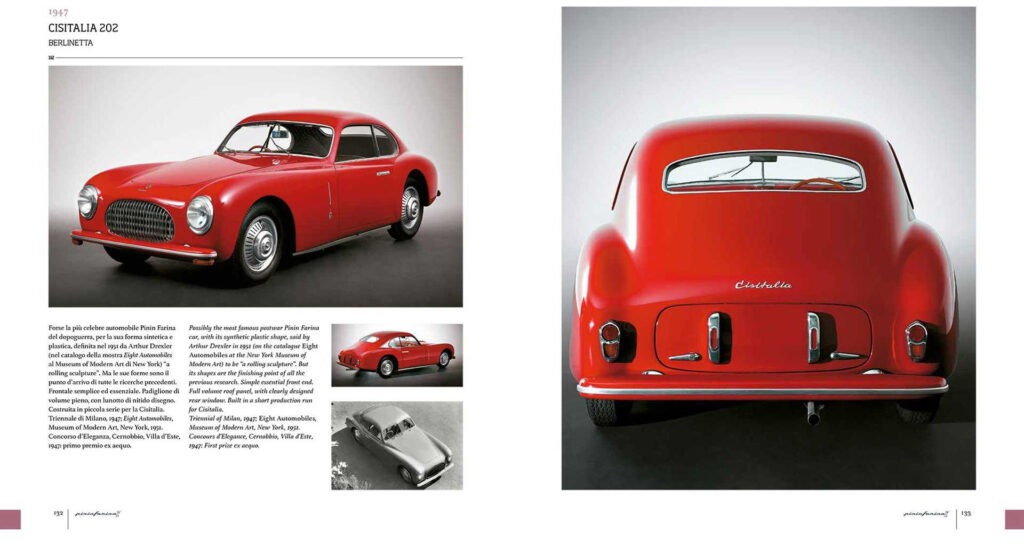
The 1940s were the decade in which mudguards were progressively integrated into the seamless surface of the sides, but this was above all the decade in which Pinin Farina designed the Cisitalia 202 berlinetta (1947), an authentic “moving sculpture” and icon of automotive design.
Real success, however, arrived in the Fifties when Pinin Farina, which had by now entered a more industrial dimension, though without ever losing sight of its craftsmanship origins, opened the door to new partnerships, most importantly with Ferrari and Peugeot. In that period Pinin Farina put its name to a series of masterpieces: the Alfa Romeo Giulietta spider (1954), the Lancia Aurelia B24 S and the Aurelia Florida, both from 1955, without forgetting the various Ferrari 250 GTs that would find their crown jewel in the short wheelbase 250 GT berlinetta at the end of the decade.
This leitmotif of excellence continued in the Sixties – which also saw the death of the founder Battista, “Pinin” in 1966 – marked by other landmarks in car design like the Ferrari 250 LM (1963), the Alfa Romeo 1600 Spider, alias “Duetto” (1966), the Dino 206 GT (1967) or the Ferrari 365 GTB/4 “Daytona” of 1968, to which we might add prototypes of great appeal and charm such as the Dino berlinetta speciale (1965) or the “triptych” Sigma Grand Prix, Alfa Romeo 33 and Ferrari 512. These three concepts from 1969, passed the metaphorical baton on to the sensational Modulo, at the dawn of the 1970s, which in their turn were distinguished by other iconic Ferraris but also by models later produced on an industrial scale for Peugeot – another historic Pininfarina client – and Lancia.
The Eighties turned out to be just as lively with the debut of the iconic Testarossa, the 8-cylinder Ferrari family that continued to acquire new members (the iconic GTO of 1984, the F40 of 1987 and the 348 of 1989), and the partnership with Peugeot that generated the unforgettable 205 (1983), while the collaboration with General Motors led to the creation of the sumptuous Allanté, offspring of the longest assembly line in the world: the bodies were built by Pininfarina and shipped to Detroit to be assembled with the mechanicals.
Multiple collaboration agreements were also a feature of the Nineties: the one with Ferrari that led to the birth of the 456 GT (1992); new 8 cylinder models, the F355 (1994) and the 360 Modena (1999); and the sensational F50 of 1995. But this was also the decade of the Fiat Coupé (1994), the Alfa Romeo Spider and the GTV, both dated 1995, and the Peugeot 406 coupé (1997).
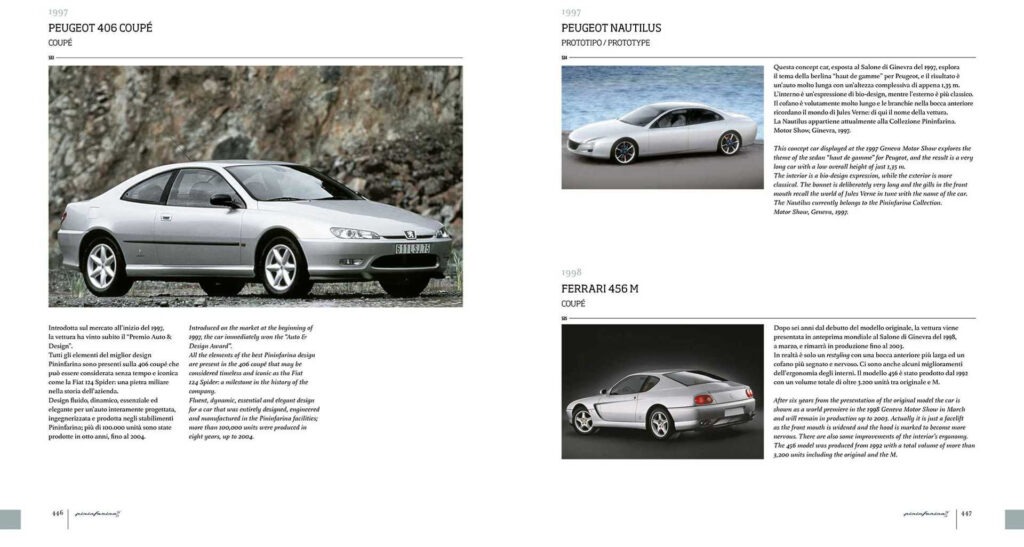
So here we are in the first two decades of the new millennium, twenty years during which Pininfarina has continued to contribute to the Ferrari product range by designing and collaborating in the creation of new models, while for Maserati it has designed the Birdcage 75th concept car as well as a family of vehicles of undoubted appeal like the Quattroporte of 2003, the GranTurismo of 2007 and the GranCabrio of 2009, and has given life to sensational environmentally-friendly concepts and hybrids such as the Nido, Sintesi and Blue Car, the last two presented during the chairmanship of Andrea Pininfarina, who died prematurely in 2008. But there is more: in these same years the company signed up to a series of collaboration agreements in China, confirming its status as an unparalleled exporter of Italian design in the world. Also noteworthy in 2013, the Ferrari Sergio, dedicated to the memory of Sergio Pininfarina, who passed away in 2012, and the BMW Pininfarina Gran Lusso Coupé.
The book closes with the Pininfarina Battista concept (2019) and the Battista Anniversario (2020), two evocative concepts designed for the new company “Automobili Pininfarina“, which contain the moniker Battista in their name, a tribute to the founder of this extraordinary and unrepeatable story of style, art and industry.
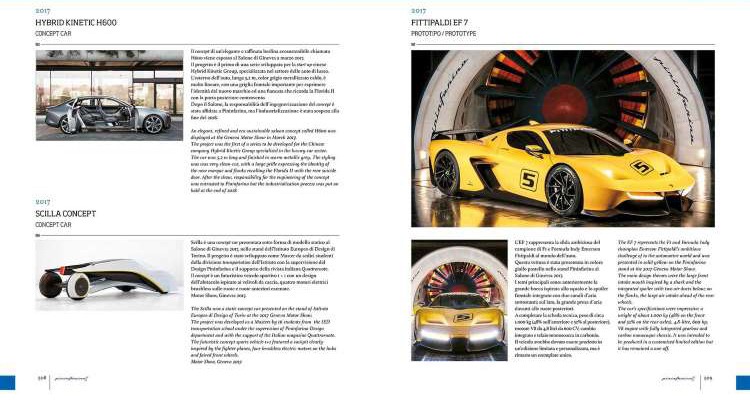
“Pininfarina 90 anni/90 years”, which describes 632 models produced from 1930 to 2020, dedicates a specific record for each car containing a short descriptive text and accompanied by one or more images, depending on the importance of the car. A reference book and, at the same time, a precious tool for car history lovers to consult but also for the neophyte eager to learn about a long, exciting history.
“This book is an important moment in the celebrations for the Company’s 90th anniversary”, explains Chairman Paolo Pininfarina. “Underlying it was the desire to be able to review all our automotive projects so as to weigh up their merits and defects too, years later: an enthralling, passionate operation for me and, I hope, also of interest to the reader”.
Published by Giorgio Nada Editore, the book is available online here
Pininfarina 90 Anni/90 Years
Preface by Paolo Pininfarina
Published by Giorgio Nada Editore
Format: 26 x 28.5 cm
528 pages, bound with dust jacket
approx. 800 colour and B/W images
Bilingual text: Italian/English
EAN: 9788879118095
Europe: October 2020
€ 90 / £ 90.00 / US$ 150.00


